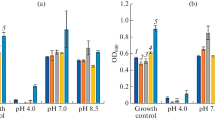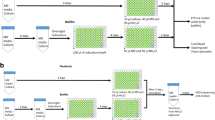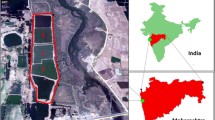Abstract
The present study was conducted with the aim of isolation and identification of the biofilm-forming denitrifying Pseudomonas bacterial strains from eutrophic waters of Dal lake, India, followed by the study of inter-relation of biofilm formation and denitrification potential of Pseudomonas strains. The bacterial strains were characterized by morphological observations and identified using 16S rDNA sequencing followed by the quantification of biofilm formation of these st by crystal violet (CV) assay using 96-well microtiter plate and extracellular polymeric substance (EPS) extraction. Lastly, the nitrate-reducing potential of all Pseudomonas species was studied. Our evaluation revealed that four different Pseudomonas species were observed to have the biofilm-forming potential and nitrate-reducing properties and the species which showed maximum biofilm-forming potential and maximum EPS production exhibited higher nitrate-removing capacity. Moreover, P. otitis was observed to have the highest denitrification capacity (89%) > P. cedrina (83%) > P. azotoform (79%) and the lowest for P. peli (70%). These results clearly signify a positive correlation of biofilm-forming capacity and nitrate-removing ability of Pseudomonas species. This study has for the first time successfully revealed the bioremediation potential of P. otitis, P. cedrina, P. azotoform, and P. peli species, thus contributing to the growing list of known nitrate-reducing Pseudomonas species. Based upon the results, these strains can be extrapolated to nitrate-polluted water systems for combating water pollution.









Similar content being viewed by others
Data availability
Data about the 16S rRNA gene sequences have been deposited at NCBI GenBank under the accession numbers MW979592, MW979593, MW774332, and MW979605. https://www.ncbi.nlm.nih.gov/nuccore/MW979592,MW979593,MW774332,MW979605.
References
Abbew AA, Amadu AA, Qiu S, Champagne P, Adebayo I, Anifowose PO and Ge S (2022). Understanding the influence of free nitrous acid on microalgal-bacterial consortium in wastewater treatment: A critical review. Bioresour Technol, 363:127916. https://doi.org/10.1016/j.biortech.2022.127916
Abdel-Aziz MH, El-Ashtoukhy ESZ, Zoromba MS, Bassyouni M, Sedahmed GH (2019) Removal of nitrates from water by electrocoagulation using a cell with horizontally oriented A1 serpentine tube anode. J Ind Eng Chem 82:105–112
Ali B, Sajjad W, Ilahi N, Bahadur A, Kang S (2022) Soot biodegradation by psychrotolerant bacterial consortia. Biodegradation 33:407–418. https://doi.org/10.1007/s10532-022-09990-1
Amin I, Nazir R, Rather MA (2021) Nano-bioremediation: an innovative approach for remedying heavy metals using fungi. J Bioremediat Biodegrad 12:487
Baghour M (2019) Algal degradation of organic pollutants. Handbook of eco materials. Springer, Cham, pp 565–586
Bhat RK, Mehmood MA, Mushtaq N, Dar H, Dar GH, Bhat A, Darvesh MA (2017) Current status of nutrient load in Dal Lake of Kashmir Himalaya. J Pharmacogn Phytochem 6(6):165–169
Cataldo DA, Maroon M, Schrader LE, Youngs VL (1975) Rapid colorimetric determination of nitrate in plant tissue by nitration of salicylic acid. Commun Soil Sci Plant Anal 6:71–80
Christensen GD, Simpson WA, Younger JJ et al (1985) Adherence of coagulase-negative Staphylococci to plastic tissue culture plates: a quantitative model for the adherence of Staphylococci to medical devices. J Clin Microbiol 22:996–1006
Cipriano MA, Lupatini M, Lopes-Santos L, da Silva MJ, Roesch LF, Destéfano SA, Freitas SS, Kuramae EE (2016) Lettuce and rhizosphere microbiome responses to growth promoting Pseudomonas species under field conditions. FEMS Microbiol Ecol 92(12):fiw197. https://doi.org/10.1093/femsec/fiw197
Costa OYA, Raaijmakers JM, Kuramae EE (2018) Microbial extracellular polymeric substances: ecological function and impact on soil aggregation. Front Microbiol 9:1636. https://doi.org/10.3389/fmicb.2018.01636
Culotti A, Packman AI (2014) Pseudomonas aeruginosa promotes Escherichia coli biofilm formation in nutrient-limited medium. PLoS One 9(9):e107186
Dasgupta D, Ghosh R, Sengupta TK (2013) Biofilm-mediated enhanced crude oil degradation by newly isolated Pseudomonas species. ISRN Biotechnol 2013:250749. https://doi.org/10.5402/2013/250749
Decho AW (2000) Microbial biofilms in intertidal systems: an overview. Cont Shelf Res 20:1257–1273
Dong Y, Wang Z, Li L, Zhang X, Chen F, He J (2023) Heterotrophic nitrification and aerobic denitrification characteristics of the psychrotolerant Pseudomonas peli NR-5 at low temperatures. Bioprocess Biosyst Eng 46(5):693–706
Edwards SJ, Kjellerup BV (2013) Applications of biofilms in bioremediation and biotransformation of persistent organic pollutants, pharmaceuticals/personal care products, and heavy metals. Appl Microbiol Biotechnol 97:9909–9921. https://doi.org/10.1007/s00253-013-5216-z
Flemming HC (2016) EPS-then and now. Microorganisms 4:41
Gomez Isaza DF, Cramp RL, Franklin CE (2020) Negative impacts of elevated nitrate on physiological performance are not exacerbated by low pH. Aquat Toxicol 200:217–225
Häder DP, Banaszak AT, Villafañe VE, Narvarte MA, González RA, Helbling EW (2020) Anthropogenic pollution of aquatic ecosystems: Emerging problems with global implications. Science Total Environ, 713:136586. https://doi.org/10.1016/j.scitotenv.2020.136586.
Han X, Wang Z, Chen M, Zhang X, Tang CY, Wu Z (2017) Acute responses of microorganisms from membrane bioreactors in the presence of NaOCl: protective mechanisms of extracellular polymeric substances. Environ Sci Technol 51(6):3233–3241
He T, Li Z, Xu Y (2015a) Denitrifcation characteristics of a hypothermia nitrite-denitrifer Pseudomonas putida Y-12. Acta Sci Circum 35:3071–3077
He T, Xu Y, Li Z (2015b) Identifcation and characterization of a hypothermia nitrite bacterium Pseudomonas tolaasii Y-11. Wei Sheng Wu Xue Bao 55(8):991–1000
Holt JG, Krieg NR, Sneath PH, Staley JT, Williams ST (1994) Bergey’s manual of determinative bacteriology, 9th edn. Lippincott Williams and Wilkins, Baltimore
Horn H, Morgenroth E (2006) Transport of oxygen, sodium chloride, and sodium nitrate in biofilms subsequent environmental. Chem Eng Sci 61:1347–1356
Huang J, Xu CC, Ridoutt BG, Wang XC and Ren PA (2017) Nitrogen and phosphorus losses and eutrophication potential associated with fertilizer application to cropland in China. J Clean Prod, 159:171-179. https://doi.org/10.1016/j.jclepro.2017.05.008
Huang X, Jiang D, Ni J, Xie D, Li Z (2021) Removal of ammonium and nitrate by the hypothermia bacterium Pseudomonas putida Y-9 mainly through assimilation. Environ Technol Innov 22:101458. https://doi.org/10.1016/j.eti.2021.101458
Huang X, Luoluo Xie D, Li Z (2023) Dissimilatory nitrate reduction to ammonium in four Pseudomonas spp. under aerobic conditions. Heliyon 9(4):e14983. https://doi.org/10.1016/j.heliyon.2023.e14983
Hussain A, Rehman F, Rafeeq H, Waqas M, Asghar A, Afsheen N, Rahdar A, Bilal M, Iqbal HMN (2022) In-situ, ex-situ, and nano-remediation strategies to treat polluted soil, water, and air—a review. Chemosphere 289:133252. https://doi.org/10.1016/j.chemosphere.133252
Jia R, Wang Z, Cheng W, Liu X, Li T (2018) Study on the denitrification performance of Pseudomonas fluorescens and the microbial community analysis. J Environ Manage 209:452–459
Kalyuzhnyi S, Gladchenko M, Mulder A (2008) Denitrification with methane as external carbon source: the role of denitrifying bacteria. Water Sci Technol 57(3):421–427
Karches T, Buzás K (2013) Investigation of residence time distribution and local mean age of fluid to determine dead-zones in flow field. Int J Comput Methods Exp Meas 1(2):132–141. https://doi.org/10.2495/CMEM-V1-N2-132-141
Kenichi K, Mineji H, Satoshi G (2016) Severe methemoglobinemia due to sodium nitrite poisoning. Case Rep Emerg Med 2016:9013816. https://doi.org/10.1155/2016/9013816
Khan M U, Dutta N, Sarwar A, Ahmad M, Yousaf M, Kadmi Y, Shariati MA (2022) Microalgal-bacterial consortia for biomass production and wastewater treatment. In: El-Sheekh M, Abomohra AE-F (eds) Handbook of algal biofuels. Elsevier, Amsterdam, pp 477–501. https://doi.org/10.1016/B978-0-12-823764-9.00013-3.
Khan M, Mohammad F (2014) Eutrophication: Challenges and Solutions. In: Ansari, A., Gill, S. (eds) Eutrophication: Causes, Consequences and Control. Springer, Dordrecht. https://doi.org/10.1007/978-94-007-7814-6_1
Kumar S, Stecher G, Li M, Knyaz C, Tamura K (2018) MEGA X: molecular evolutionary genetics analysis across computing platforms. Mol Biol Evol 35:1547–1549
Lalucat J, Bennasar A, Bosch R, Garcia-Valdes E, Palleroni NJ (2006) Biology of Pseudomona stutzeri. Microbiol Mol Biol Rev 70:510–547
Li Y, Ling J, Chen P, Chen J, Dai R, Liao J, Yu J, Xu Y (2021) Pseudomonas mendocina LYX: a novel aerobic bacterium with advantage of removing nitrate high effectively by assimilation and dissimilation simultaneously. Front Environ Sci Eng 15:57. https://doi.org/10.1007/s11783-020-1349-3
Limoli DH, Jones CJ, Wozniak DJ (2015) Bacterial extracellular polysaccharides in biofilm formation and function. Microbiol Spectr 3. https://doi.org/10.1128/microbiolsec.MB-0011-2014
Liu Y, Zhang R, Wang Y, Liu H, Yang G (2020) Isolation and identification of a denitrifying strain Pseudomonas aeruginosa and its potential application in groundwater nitrate removal. Environ Sci Pollut Res 27(17):21155–21164
Lu C, Tian H (2017) Global nitrogen and phosphorus fertilizer use for agriculture production in the past half century: shifted hot spots and nutrient imbalance. Earth Syst Sci Data 9:181–192. https://doi.org/10.5194/essd-9-181-2017
Mahmood A, Bilal B, Naeem Z, Iram S (2021) Physical, chemical, and biological remediation techniques for textile effluents in context with developed and developing countries. In: Rhizobiont in bioremediation of hazardous waste. Springer, Singapore, pp 409–441
Mahto K, Vandana, Priyadarshanee M, Samantaray Devi P, Das Surajit (2022) Bacterial biofilm and extracellular polymeric substances in the treatment of environmental pollutants: beyond the protective role in survivability. J Clean Prod 379(Part 2):134759. https://doi.org/10.1016/j.jclepro.2022.134759
Mangwani N, Kumari S, Das S (2015) Involvement of quorum sensing genes in biofilm development and degradation of polycyclic aromatic hydrocarbons by a marine bacterium Pseudomonas aeruginosa N6P6. Appl Microbiol Biotechnol 99:10283–10297. https://doi.org/10.1007/s00253-015-6868-7
Masák J, Čejková A, Schreiberová O, Řezanka T (2014) Pseudomonas biofilms: possibilities of their control. FEMS Microbiol Ecol 89(1):1–14. https://doi.org/10.1111/1574-6941.12344
Merritt JH, Kadouri DE, O’Toole GA (2006) Growing and analyzing static biofilms. Curr Protoc Microbiol 1:Unit–1B(1):1–29
Mingxia Z, Anzhang L, Qing Y, Botao X, Honghui Z (2022) Pseudomonas oligotrophica sp. nov., a novel denitrifying bacterium possessing nitrogen removal capability under low carbon-nitrogen ratio condition. Front Microbiol 13:882890. https://doi.org/10.3389/fmicb.2022.882890
Moe M, Yan J, Nobre MF, da Costa MS, Stahl DA (2012) Draft genome sequence of Pseudomonas putida strain W619, a denitrifying organism. J Bacteriol 194(6):1626–1627
Nasiri H, Forouzandeh M, Rasaee MJ, Rahbarizadeh F (2005) Modified salting-out method: high-yield, high-quality genomic DNA extraction from whole blood using laundry detergent. J Clin Lab Anal 19:229–232
Nazir R, Zaffar R, Amin I (2019) Bacterial biofilms: freshwater microbiology. Perspectives of bacterial dynamics in lake ecosystems. pp 307–340
Paruch L, Paruch AM, Eiken HG, Sørheim R (2019) Faecal pollution affects abundance and diversity of aquatic microbial community in anthropo-zoogenically influenced lotic ecosystems. Sci Rep 9:19469. https://doi.org/10.1038/s41598-019-56058-x
Rastegari AA, Yadav AN, Yadav MNV (2020) New and future developments in microbial biotechnology and bioengineering: trends of microbial biotechnology for sustainable agriculture and biomedicine systems: diversity and functional perspectives. Elsevier
Rivoira L, Castiglioni M, Nurra N, Battuello M, Sartor RM, Favaro L, Bruzzoniti MC (2022) Polycyclic aromatic hydrocarbons and polychlorinated biphenyls in seawater sediment and biota of neritic ecosystems: occurrence and partition study in Southern Ligurian Sea. Appl Sci 12:2564. https://doi.org/10.3390/app12052564
Rodríguez-Sánchez A, Linares-Pastén JA, Lazzarini LE, Fajardo C, Silva-Aciares F (2021) Isolation and characterization of a Pseudomonas sp. D48 strain for efficient nitrate removal from groundwater. J Environ Chem Eng 9(1):104812
Sharma A, Jamali H, Vaishnav A, Giri BS, Srivastava AK (2020) Microbial biofilm: an advanced eco-friendly approach for bioremediation. New and future developments in microbial biotechnology and bioengineering: microbial biofilms. Elsevier, pp 205–219
Smitinont T, Tansakul C, Tanasupawat S, Keeratipibul S, Navarini L, Bosco M, Cescutti P (1999) Exopolysaccharide producing lactic acid bacteria strains from traditional Thai fermented foods, isolation, identification and exopolysaccharide characterization. Int J of Food Microbiol 51:105–111
Sonawane JM, Rai AK, Sharma M, Tripathi M, Prasad R (2022) Microbial biofilms: recent advances and progress in environmental bioremediation. Sci Total Environ. 824:153843. https://doi.org/10.1016/j.scitotenv.2022.153843
Sonune N (2021) Microbes: a potential tool for bioremediation. In: Vivek K, Ram P, Manoj K (eds) Rhizobiont in bioremediation of hazardous waste. Springer, Singapore, pp 391–407
Stepanovic S, Vukovic D, Hola V, Bonaventura GD, Djukic S, Circovic I, Ruzicka F (2007) Quantification of biofilm in microtiter plates. APMIS 115:891–899
Suizhou R, Jun G, Guoqu Z, Guoping S (2006) Decolorization of triphenylmethane, azo, and anthraquinone dyes by a newly isolated Aeromonas hydrophila strain. Appl Microbiol Biotechnol 72:1316–1321
Temkin A, Evans S, Manidis T, Campbell C, Naidenko OV (2019) Exposure-based assessment and economic valuation of adverse birth outcomes and cancer risk due to nitrate in United States drinking water. Environ Res 176:108442
Thi M, Wibowo D, Rehm B (2020) Pseudomonas aeruginosa biofilms. Int J Mol Sci 21(22):8671. https://doi.org/10.3390/ijms21228671
Tolker-Nielsen T, Berinch UC, Ragas PC, Andersen JB, Jacobsen CS, Molin S (2020) Development and dynamics of Pseudomonas sp. biofilms. J Bacteriol 182(2):6482–6489
Tomczyk P, Gałka B, Wiatkowski M, Wdowczyk A, Gruss Ł (2022) Toxicity studies on sediments near hydropower plants on the Ślęza and Bystrzyca rivers Poland to establish their potential for use for soil enrichment. Land Degrad Dev 33(5):756–770. https://doi.org/10.1002/LDR.4210
Trabelsi AN, Guermazi W, Leignel V, Al-Enezi Y, Karam Q, Ali M, Ayadi H, Belmonte G (2022) Effects of eutrophication on plankton abundance and composition in the Gulf of Gabès (Mediterranean Sea, Tunisia). Water 14(14):2230. https://doi.org/10.3390/w14142230
Ugya AY, Imam TS, Ma J (2019) Mini-review on the efficiency of aqutic macrophytes as mosquito larvicide. J Appl Bot Food Qual 92:320–326
Uqab B, Mudasir S, Sheikh AQ, Nazir R (2016) Bioremediation: a management tool. J Bioremed Biodegrad 7:331. https://doi.org/10.4172/2155-6199.1000331
Wang Z, Luo Z, Yan C, Rosenfeldt RR, Seitz F, Gui H (2018) Biokinetics of arsenate accumulation and release in microcystis aeruginosa regulated by common environmental factors: practical implications for enhanced bioremediation. J Clean Prod 199:112–120. https://doi.org/10.1016/j.jclepro.2018.07.131
Wang WF, Cao LX, Tan HM, Zhang RD (2019a) Nitrogen removal from synthetic wastewater using single and mixed culture systems of denitrifying fungi, bacteria, and actinobacteria. Appl Microbiol Biotechnol 100:9699–9707. https://doi.org/10.1007/s00253-016-7800-5
Wang X, Ma S, Wang H, Zhang Y, Ma F, Sun X, Song C (2019b) Efficient nitrate removal by a newly isolated Pseudomonas stutzeri strain YX-2 and its application for wastewater treatment. Environ Sci Pollut Res 26(35):35607–35616
Yoshikawa M, Zhang M, Toyota K (2017) Integrated anaerobic-aerobic biodegradation of multiple contaminants including chlorinated ethylenes, benzene, toluene, and dichloromethane. Water Air Soil Pollut 228:25
Zaffar R, Nazir R, Rather MA (2022) Bacterial biofilms: deeper insights into their formation, architecture and applications. J Res Dev 21
Zhang Y, Liu X, Qin B, Shi K, Deng J, Zhou Y (2016) Aquatic vegetation in response to increased eutrophication and degraded light climate in Eastern Lake Taihu: Implications for lake ecological restoration. Sci Rep 6:23867 https://doi.org/10.1038/srep23867
Zhao C, Yuli J, Zhiqiang C, Jiajia W, Xiefa S, Zhitao H, Shibo C, Jian L (2020) Denitrification characteristics and pathways of a facultative anaerobic denitrifying strain, Pseudomonas denitrificans G1. J Biosci Bioeng 129(6):715–722. https://doi.org/10.1016/j.jbiosc.2019.12.011
Acknowledgements
The authors are highly thankful to Director CORD, previous directors, Department of Environmental Science/Centre of Research for Development (CORD), University of Kashmir, Department of Chemical Engineering, NIT, Srinagar for providing laboratory facilities to carry out the research work and special thanks to Department of Science and Technology (DST), Govt. of India for funding the research work
Funding
The financial support of the research work was provided by the Department of Science and Technology (DST), Govt. of India, under Women Scientist’s scheme (WOS-A) vide reference number SR/WOS-A/LS-232/2018.
Author information
Authors and Affiliations
Contributions
RZ: Concept, design, collection, conducting experiments, compilation, interpretation of data, writing—original draft, editing, data curation, and formal analysis. RN: Concept, design, interpretation of data, data curation, formal analysis, review and editing. MAR: Concept design, interpretation of data, data curation, formal analysis, review, and editing. RD: Interpretation of data, review and editing. All authors contributed to the article and approved the submitted version.
Corresponding author
Ethics declarations
Conflict of interest
The authors have no relevant financial or non-financial interests to disclose. The authors have no competing interests to declare that are relevant to the content of this article. All authors certify that they have no affiliations with or involvement in any organization or entity with any financial interest or non-financial interest in the subject matter or materials discussed in this manuscript. The authors have no financial or proprietary interests in any material discussed in this article.
Ethics approval and consent to participate
Not applicable.
Consent to publish
Not applicable.
Additional information
Communicated by Yusuf Akhter.
Publisher's Note
Springer Nature remains neutral with regard to jurisdictional claims in published maps and institutional affiliations.
Rights and permissions
Springer Nature or its licensor (e.g. a society or other partner) holds exclusive rights to this article under a publishing agreement with the author(s) or other rightsholder(s); author self-archiving of the accepted manuscript version of this article is solely governed by the terms of such publishing agreement and applicable law.
About this article
Cite this article
Zaffar, R., Nazir, R., Rather, M.A. et al. Biofilm formation and EPS production enhances the bioremediation potential of Pseudomonas species: a novel study from eutrophic waters of Dal lake, Kashmir, India. Arch Microbiol 206, 89 (2024). https://doi.org/10.1007/s00203-023-03817-0
Received:
Revised:
Accepted:
Published:
DOI: https://doi.org/10.1007/s00203-023-03817-0




